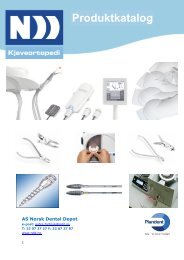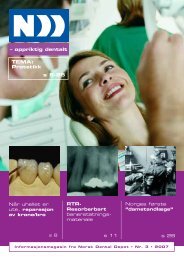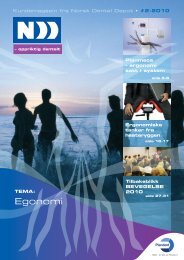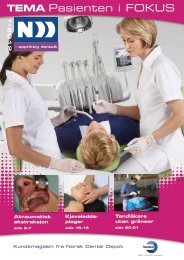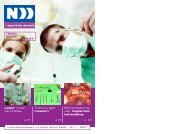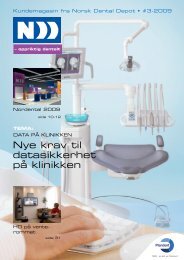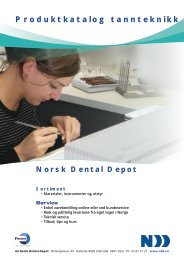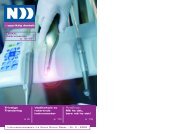Biodentine
Biodentine
Biodentine
You also want an ePaper? Increase the reach of your titles
YUMPU automatically turns print PDFs into web optimized ePapers that Google loves.
26<br />
The inflammatory process had disappeared after 15 days. The newly formed reactionary<br />
dentine was identified. By comparison with the group treated with the glass ionomer<br />
cement, the formation of reactionary dentine was greater in the teeth in the presence of<br />
<strong>Biodentine</strong> and its thickness increased over time from 20 to 40 µm after 8 days, 40 to<br />
80 µm after 15 days and 140 to 280 µm after 30 days, although it varied between 10<br />
and 20 µm for the reference group. After 3 months, reactionary dentine generated by<br />
<strong>Biodentine</strong> was thick and dense (Fig. 12), enclosing the horn and the mesial pulp whilst<br />
for Fuji IX, this was less dense, only partially covering the mesial cervical area of the pulp<br />
(Golberg, 2009).<br />
Fig. 12. Formation of a thick reactionary dentine in presence of to <strong>Biodentine</strong> in comparison to Fuji IX<br />
To conclude, <strong>Biodentine</strong> was able to stimulate a reactionary dentine which is a natural<br />
barrier against bacterial invasions. The reactionary dentine formation stabilises at<br />
3 months, indicating that the stimulation process is stopped when a sufficient dentine<br />
barrier is formed.<br />
5.4 - Calcification as a result of <strong>Biodentine</strong> in a direct<br />
pulp capping and pulpotomy : pig model<br />
Two protocols were set up in pigs (Shayegan A, 2009).<br />
The first protocol was the analysis of the pulp reaction following pulpotomy and<br />
placement of different materials (15 deciduous teeth, 15 pigs):<br />
• Formocresol<br />
• White MTA<br />
• <strong>Biodentine</strong><br />
The follow-up was performed during 1, 4 and 12 weeks.<br />
Pulp chamber was excised in 15 pigs in a comparative study of the efficacy of<br />
<strong>Biodentine</strong> versus formocresol and MTA (5 pigs per group). Histological sections of<br />
the teeth were done after a week, a month and 3 months of treatment. The results<br />
showed that <strong>Biodentine</strong>, like White MTA, promoted beneficial calcification after one<br />
week, whereas Formocresol induced necrosis and inflammation (Fig. 13).



